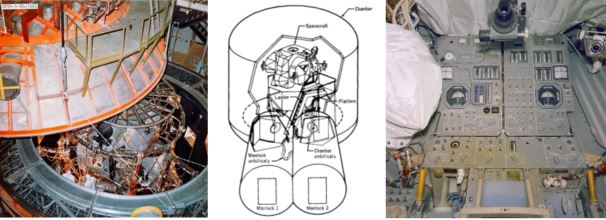In the fall of 1968, NASA conducted critical tests at the Manned Spacecraft Center (MSC) in Houston to certify the Apollo Lunar Module (LM) for lunar missions. Successful completion of these thermal-vacuum tests, conducted in the Space Environment Simulation Laboratory (SESL), were required before the first crewed flight of the LM to lunar distances. Earlier tests in May 1968 using Lunar Module Test Article (LTA) 8 certified the LM for Earth orbital missions. The SESL houses two chambers for thermal-vacuum testing. Chamber A is the larger of the two chambers and tested the Apollo Command and Service Module in June for Earth orbital and in September for lunar missions. The smaller Chamber B is a 35-foot diameter stainless steel vessel with an overall height of 43 feet that can accommodate a vehicle 13 feet in diameter and 27 feet in length.
Based on lessons learned from the May testing, NASA engineers implemented several modifications to LTA-8 (and to actual flight LMs), such as improving how the layers of insulation vent any trapped air to the vacuum of space and upgrading the atmospheric revitalization system. To save money and time, engineers modified the vehicle in the tight confines of Chamber B rather than shipping it back to the manufacturer, the Grumman Aircraft Engineering Corporation in Bethpage, New York. During the tests, the chamber maintained a vacuum simulating an altitude of about 150 miles and temperatures as low as -300o F. Strip heaters attached to the LTA’s surface provided the simulated solar heat.
The test program was divided into cold soak and hot soak phases, with crews entering and exiting the LTA during the tests. The cold soak ran from October 14 to 27, lasted 280 hours and included a simulated translunar flight, descent from lunar orbit, lunar landing and stay, and ascent to lunar orbit. There were two crewings during the cold soak phase on October 23 and 25. The hot soak test took place between November 7 and 20, lasted 270 hours and repeated the cold soak simulation, adding a second descent from lunar orbit, lunar stay, and ascent to lunar orbit. The hot soak phase included three crewed periods on November 10, 12, and 14. For this series of tests, NASA selected Grumman Aircraft consulting pilots Gerald P. Gibbons and Glennon M. Kingsley as the prime crew with astronaut James B. Irwin serving as a backup, although each participated in at least 2 of the runs. All three had also participated in the May test campaign.
The successful completion of the test campaign on November 19 removed any thermal-vacuum constraints to crewed LM lunar missions. The few anomalies that occurred were resolved at the component or subsystem level before the first crewed LM flight to the Moon. Workers removed the LTA-8 from Chamber B on December 9. NASA transferred the LTA-8 to the Smithsonian in 1978 and it is now on public display at Space Center Houston.
Read James McLane’s recollections of the SESL from his oral history with the JSC History Office.





























